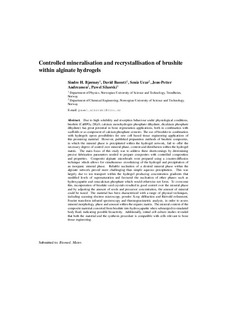Controlled mineralisation and recrystallisation of brushite within alginate hydrogels
Journal article, Peer reviewed
Permanent lenke
http://hdl.handle.net/11250/2430349Utgivelsesdato
2016-02Metadata
Vis full innførselSamlinger
- Institutt for fysikk [2695]
- Institutt for kjemisk prosessteknologi [1777]
- Publikasjoner fra CRIStin - NTNU [38127]
Originalversjon
10.1088/1748-6041/11/1/015013Sammendrag
Due to high solubility and fast resorption behaviour under physiological conditions, brushite (CaHPO4⋅2H2O, calcium monohydrogen phosphate dihydrate, dicalcium phosphate dihydrate) has great potential in bone regeneration applications, both in combination with scaffolds or as a component of calcium phosphate cements. The use of brushite in combination with hydrogels opens up possibilities for new cell-based tissue engineering applications of this promising material. However, published preparation methods of brushite composites, in which the mineral phase is precipitated within the hydrogel network, fail to offer the necessary degree of control over the mineral phase, content and distribution within the hydrogel matrix. The main focus of this study is to address these shortcomings by determining the precise fabrication parameters needed to prepare composites with controlled composition and properties. Composite alginate microbeads were prepared using a counter-diffusion technique, which allows for the simultaneous crosslinking of the hydrogel and precipitation of an inorganic mineral phase. Reliable nucleation of a desired mineral phase within the alginate network proved more challenging than simple aqueous precipitation. This was largely due to ion transport within the hydrogel producing concentration gradients that modified levels of supersaturation and favoured the nucleation of other phases such as hydroxyapatite and octacalcium phosphate, which would otherwise not form. To overcome this, the incorporation of brushite seed crystals resulted in good control during the mineral phase, and by adjusting the number of seeds and amount of precursor concentration, the amount of mineral could be tuned. The material was characterised with a range of physical techniques, including scanning electron microscopy, powder x-ray diffraction and Rietveld refinement, Fourier transform infrared spectroscopy, and thermogravimetric analysis, in order to assess the mineral morphology, phase and amount within the organic matrix. The mineral content of the composite material converted from brushite into hydroxyapatite when submerged in simulated body fluid, indicating possible bioactivity. Additionally, initial cell culture studies revealed that both the material and the synthesis procedure are compatible with cells relevant to bone tissue engineering.
